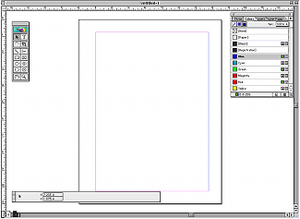We were discussing desktop publishing, layout and design, and we were discussing the various software applications people use in this field, when one of my colleagues asked what ever happened to Adobe Pagemaker.
Ah, Pagemaker, that takes me back to days long before computers were popular for layout and design. Incidentally, Adobe Pagemaker was morphed into Adobe’s Creative Suite (CS) and became Adobe Indesign.
But my mind began to wander, as I described the old days of layout and design. Back then, the tools of the trade were anything but high tech. Cork cutting boards, Xacto knives, rulers, scissors, rollers and burning, BURNING hot
 Image via Wikipedia
Image via Wikipedia
Many times I’d burn myself on the hot wax, rushing to paste together a story in time for a print run. Luckily it was like a candle burn, nothing major.
Back then, printed pages were literally cut and pasted together on long wax coated pages called “proofs.” Hot wax was rolled onto these proofs, and each story was cut into pieces, and each piece was coated in this hot wax. The wax would allow you to slide each bit into the perfect spot in the layout, creating a page in the newspaper. Then the pages were hung like freshly washed clothes to dry.
It was a time consuming process, requiring steady hands, and a solid eye for being able to see when things were aligned just right. The most skilled at this could eyeball a single line of type (say a headline) without a ruler, and just know when it was perfectly straight on the page.
Though each proof came with pastel pink and blue grid lines, showing you the way.
To reduce some of the repetitive tasks of this
 Image via Wikipedia
Image via Wikipedia
The “paste-up board” as it was often called, because it had elements (such as page identifiers, logos, staff by-lines, datelines, place lines and so on) were all lying there, pre-sized and waiting to be pasted-up onto the page.
The area surrounding your pages in most desktop layout design applications is still called the paste-up board today, and is used to story common elements which can be copied into place.
These completed waxed pages would then be sent to the printers, where they would take them and create plates which they’d use for a print run.
When breaking news occurred, the poor layout designer literally had to start from scratch, because nothing was electronically designed, so the page or pages affected by the new story had to be recreated.
This was why deadlines were so very important back in those days, as a breaking news story could delay the print run of a newspaper for hours.
Once a print run begins, it takes some time to get started again, because of the way inks are printed in layers at different stages to achieve different colors and effects. So it still takes time to stop and start the actual production of a paper.
That’s why most major daily papers have two or three print runs, say a morning, afternoon and evening run. Some even have different edition runs, say one for the city, and one for distribution outside the city in the suburbs. If a breaking story changes the paper, they will toss the revised story into the next print run, instead of stopping the presses completely.
Which is partially why newspapers are in the so-called dying medium of print. Often, by the time they have hit newsstands, many of the stories are already out of date.
With 24-hour, seven-day-per-week news channels on television and radio, and with the global reach of the always on Internet, developing news stories change constantly. Newspapers can’t change once printed.
The always on electronic media also has driven us to expect news to be new the second we see it. When you read something in a newspaper, it was current at the time it was written.
And newspapers take so much time to read, while television, radio, even the Internet can broadcast the news to us, while we are making dinner, doing house cleaning, or even while working the very same computers broadcasting all this stuff.
Although newspapers are a dying breed, I miss the old days of the hot wax, Xacto Knives, and paste-up boards. Back then, laying out a page was a much more hands-on process, because you physically placed stories on the page. These days, you usually right-click on “place into frame” to put a story on the page.
It just doesn’t have the same feel.
![Reblog this post [with Zemanta]](http://img.zemanta.com/reblog_b.png?x-id=40e88049-e5ed-4e38-b023-8dcecae1cb5c)








No comments:
Post a Comment